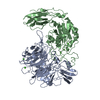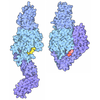[English] 日本語
 Yorodumi
Yorodumi- PDB-9dao: AlphaIIbbeta3 in fully-extended conformation in complex with R6H8 Fab -
+ Open data
Open data
- Basic information
Basic information
| Entry | Database: PDB / ID: 9dao | ||||||
|---|---|---|---|---|---|---|---|
| Title | AlphaIIbbeta3 in fully-extended conformation in complex with R6H8 Fab | ||||||
 Components Components |
| ||||||
 Keywords Keywords | BLOOD CLOTTING / alphaIIbbeta3 integrin / platelet aggregation / clot retraction | ||||||
| Function / homology |  Function and homology information Function and homology informationtube development / regulation of serotonin uptake / positive regulation of adenylate cyclase-inhibiting opioid receptor signaling pathway / alpha9-beta1 integrin-ADAM8 complex / regulation of trophoblast cell migration / integrin alphaIIb-beta3 complex / regulation of postsynaptic neurotransmitter receptor diffusion trapping / maintenance of postsynaptic specialization structure / alphav-beta3 integrin-vitronectin complex / regulation of extracellular matrix organization ...tube development / regulation of serotonin uptake / positive regulation of adenylate cyclase-inhibiting opioid receptor signaling pathway / alpha9-beta1 integrin-ADAM8 complex / regulation of trophoblast cell migration / integrin alphaIIb-beta3 complex / regulation of postsynaptic neurotransmitter receptor diffusion trapping / maintenance of postsynaptic specialization structure / alphav-beta3 integrin-vitronectin complex / regulation of extracellular matrix organization / positive regulation of glomerular mesangial cell proliferation / platelet alpha granule membrane / integrin alphav-beta3 complex / negative regulation of lipoprotein metabolic process / alphav-beta3 integrin-PKCalpha complex / fibrinogen binding / blood coagulation, fibrin clot formation / alphav-beta3 integrin-HMGB1 complex / vascular endothelial growth factor receptor 2 binding / negative regulation of lipid transport / positive regulation of vascular endothelial growth factor signaling pathway / regulation of release of sequestered calcium ion into cytosol / Elastic fibre formation / mesodermal cell differentiation / glycinergic synapse / cell-substrate junction assembly / alphav-beta3 integrin-IGF-1-IGF1R complex / positive regulation of bone resorption / platelet-derived growth factor receptor binding / filopodium membrane / extracellular matrix binding / negative regulation of low-density lipoprotein particle clearance / angiogenesis involved in wound healing / positive regulation of vascular endothelial growth factor receptor signaling pathway / apolipoprotein A-I-mediated signaling pathway / positive regulation of cell adhesion mediated by integrin / regulation of bone resorption / positive regulation of leukocyte migration / apoptotic cell clearance / wound healing, spreading of epidermal cells / positive regulation of fibroblast migration / integrin complex / positive regulation of smooth muscle cell migration / heterotypic cell-cell adhesion / smooth muscle cell migration / Molecules associated with elastic fibres / negative chemotaxis / positive regulation of cell-matrix adhesion / Mechanical load activates signaling by PIEZO1 and integrins in osteocytes / Syndecan interactions / cell adhesion mediated by integrin / p130Cas linkage to MAPK signaling for integrins / positive regulation of osteoblast proliferation / cellular response to insulin-like growth factor stimulus / protein disulfide isomerase activity / regulation of postsynaptic neurotransmitter receptor internalization / microvillus membrane / cell-substrate adhesion / platelet-derived growth factor receptor signaling pathway / PECAM1 interactions / GRB2:SOS provides linkage to MAPK signaling for Integrins / TGF-beta receptor signaling activates SMADs / fibronectin binding / lamellipodium membrane / negative regulation of macrophage derived foam cell differentiation / negative regulation of lipid storage / ECM proteoglycans / Integrin cell surface interactions / positive regulation of T cell migration / negative regulation of endothelial cell apoptotic process / coreceptor activity / cell adhesion molecule binding / cellular response to platelet-derived growth factor stimulus / positive regulation of endothelial cell proliferation / Integrin signaling / embryo implantation / positive regulation of substrate adhesion-dependent cell spreading / positive regulation of smooth muscle cell proliferation / positive regulation of endothelial cell migration / substrate adhesion-dependent cell spreading / protein kinase C binding / Turbulent (oscillatory, disturbed) flow shear stress activates signaling by PIEZO1 and integrins in endothelial cells / cell-matrix adhesion / Signal transduction by L1 / response to activity / integrin-mediated signaling pathway / regulation of actin cytoskeleton organization / wound healing / cellular response to mechanical stimulus / Signaling by high-kinase activity BRAF mutants / cell-cell adhesion / RUNX1 regulates genes involved in megakaryocyte differentiation and platelet function / MAP2K and MAPK activation / platelet activation / platelet aggregation / VEGFA-VEGFR2 Pathway / ruffle membrane / integrin binding / cellular response to xenobiotic stimulus / positive regulation of fibroblast proliferation Similarity search - Function | ||||||
| Biological species |   Homo sapiens (human) Homo sapiens (human) | ||||||
| Method | ELECTRON MICROSCOPY / single particle reconstruction / cryo EM / Resolution: 2.8 Å | ||||||
 Authors Authors | Walz, T. / Coller, B.S. / Wang, J.L. / Buitrago, L. / Wang, L. / Li, J.H. | ||||||
| Funding support |  United States, 1items United States, 1items
| ||||||
 Citation Citation |  Journal: Blood Adv / Year: 2025 Journal: Blood Adv / Year: 2025Title: An αIIbβ3 ligand-mimetic murine monoclonal antibody that produces platelet activation by engaging the FcγIIa receptor. Authors: Jialing Wang / Lorena Buitrago / Lu Wang / Jihong Li / Thomas Walz / Barry S Coller /  Abstract: To produce a murine monoclonal antibody (mAb) that binds to glycoprotein IIb/IIIa (αIIbβ3) and inhibits clot retraction (CR), we immunized mice with human platelets and tested hybridoma ...To produce a murine monoclonal antibody (mAb) that binds to glycoprotein IIb/IIIa (αIIbβ3) and inhibits clot retraction (CR), we immunized mice with human platelets and tested hybridoma supernatants for their ability to bind to αIIbβ3 and inhibit CR. The immunoglobulin G1 (IgG1) mAb R6H8 completely inhibited CR at 20 μg/mL. Paradoxically, at 5 μg/mL, R6H8 initiated platelet aggregation and induced P-selectin expression, fibrinogen binding, and PAC-1 binding. At 20 μg/mL, however, R6H8 completely inhibited aggregation induced by thrombin PAR-1 receptor activating peptide SFLLRN (T6; 25 μg/mL) and T6-induced fibrinogen and PAC-1 binding to platelets. Platelet aggregation induced by R6H8 was inhibited by mAb IV.3, which blocks the FcγIIa receptor (FcγRIIa), and the Fab fragment of R6H8 did not induce platelet aggregation, suggesting that R6H8 binds to both αIIbβ3 and FcγRIIa. Cryogenic electron microscopy analysis of the R6H8 Fab-αIIbβ3 complex revealed that R6H8 (1) binds to the αIIbβ3 RGD binding pocket via an Arg-Tyr-Asp (RYD) sequence in its heavy chain complementarity-determining region 3; (2) interacts with β3 Asp126, producing a reorientation of Asp126 and loss of the adjacent to metal ion-dependent adhesion site Ca2+; and (3) initiates swing-out of the β3 hybrid domain. We conclude that R6H8 is an αIIbβ3 ligand-mimetic mAb that activates platelets via FcγRIIa at low concentrations and potently inhibits platelet aggregation and CR at high concentrations. R6H8 simulates the actions of a number of pathological antibodies, including platelet-activating antibodies developed after therapy with αIIbβ3 inhibitors and platelet-activating antibodies in heparin-induced thrombocytopenia and vaccine-induced immune thrombotic thrombocytopenia. As such, it may be a valuable reagent for better understanding these disorders and identifying potential therapies. | ||||||
| History |
|
- Structure visualization
Structure visualization
| Structure viewer | Molecule:  Molmil Molmil Jmol/JSmol Jmol/JSmol |
|---|
- Downloads & links
Downloads & links
- Download
Download
| PDBx/mmCIF format |  9dao.cif.gz 9dao.cif.gz | 276.1 KB | Display |  PDBx/mmCIF format PDBx/mmCIF format |
|---|---|---|---|---|
| PDB format |  pdb9dao.ent.gz pdb9dao.ent.gz | 205.4 KB | Display |  PDB format PDB format |
| PDBx/mmJSON format |  9dao.json.gz 9dao.json.gz | Tree view |  PDBx/mmJSON format PDBx/mmJSON format | |
| Others |  Other downloads Other downloads |
-Validation report
| Summary document |  9dao_validation.pdf.gz 9dao_validation.pdf.gz | 1.1 MB | Display |  wwPDB validaton report wwPDB validaton report |
|---|---|---|---|---|
| Full document |  9dao_full_validation.pdf.gz 9dao_full_validation.pdf.gz | 1.1 MB | Display | |
| Data in XML |  9dao_validation.xml.gz 9dao_validation.xml.gz | 52.6 KB | Display | |
| Data in CIF |  9dao_validation.cif.gz 9dao_validation.cif.gz | 79.7 KB | Display | |
| Arichive directory |  https://data.pdbj.org/pub/pdb/validation_reports/da/9dao https://data.pdbj.org/pub/pdb/validation_reports/da/9dao ftp://data.pdbj.org/pub/pdb/validation_reports/da/9dao ftp://data.pdbj.org/pub/pdb/validation_reports/da/9dao | HTTPS FTP |
-Related structure data
| Related structure data |  46695MC  9daxC M: map data used to model this data C: citing same article ( |
|---|---|
| Similar structure data | Similarity search - Function & homology  F&H Search F&H Search |
- Links
Links
- Assembly
Assembly
| Deposited unit | 
|
|---|---|
| 1 |
|
- Components
Components
-Protein , 2 types, 2 molecules AB
| #1: Protein | Mass: 110106.391 Da / Num. of mol.: 1 / Source method: isolated from a natural source / Source: (natural)  Homo sapiens (human) / References: UniProt: P08514 Homo sapiens (human) / References: UniProt: P08514 |
|---|---|
| #2: Protein | Mass: 84478.500 Da / Num. of mol.: 1 / Source method: isolated from a natural source / Source: (natural)  Homo sapiens (human) / References: UniProt: P05106 Homo sapiens (human) / References: UniProt: P05106 |
-Antibody , 2 types, 2 molecules HL
| #3: Antibody | Mass: 24535.520 Da / Num. of mol.: 1 Source method: isolated from a genetically manipulated source Source: (gene. exp.)   |
|---|---|
| #4: Antibody | Mass: 23717.123 Da / Num. of mol.: 1 Source method: isolated from a genetically manipulated source Source: (gene. exp.)   |
-Non-polymers , 2 types, 6 molecules 


| #5: Chemical | ChemComp-CA / #6: Chemical | ChemComp-MG / | |
|---|
-Details
| Has ligand of interest | Y |
|---|---|
| Has protein modification | Y |
-Experimental details
-Experiment
| Experiment | Method: ELECTRON MICROSCOPY |
|---|---|
| EM experiment | Aggregation state: PARTICLE / 3D reconstruction method: single particle reconstruction |
- Sample preparation
Sample preparation
| Component |
| ||||||||||||||||||||||||||||
|---|---|---|---|---|---|---|---|---|---|---|---|---|---|---|---|---|---|---|---|---|---|---|---|---|---|---|---|---|---|
| Molecular weight |
| ||||||||||||||||||||||||||||
| Source (natural) |
| ||||||||||||||||||||||||||||
| Source (recombinant) | Organism:  | ||||||||||||||||||||||||||||
| Buffer solution | pH: 7.4 | ||||||||||||||||||||||||||||
| Specimen | Embedding applied: NO / Shadowing applied: NO / Staining applied: NO / Vitrification applied: YES | ||||||||||||||||||||||||||||
| Specimen support | Grid material: COPPER / Grid mesh size: 400 divisions/in. / Grid type: Quantifoil R1.2/1.3 | ||||||||||||||||||||||||||||
| Vitrification | Instrument: FEI VITROBOT MARK IV / Cryogen name: ETHANE / Humidity: 100 % / Chamber temperature: 277 K |
- Electron microscopy imaging
Electron microscopy imaging
| Experimental equipment |  Model: Titan Krios / Image courtesy: FEI Company |
|---|---|
| Microscopy | Model: FEI TITAN KRIOS |
| Electron gun | Electron source:  FIELD EMISSION GUN / Accelerating voltage: 300 kV / Illumination mode: FLOOD BEAM FIELD EMISSION GUN / Accelerating voltage: 300 kV / Illumination mode: FLOOD BEAM |
| Electron lens | Mode: BRIGHT FIELD / Nominal defocus max: 2500 nm / Nominal defocus min: 1200 nm |
| Image recording | Electron dose: 54 e/Å2 / Film or detector model: GATAN K3 (6k x 4k) |
- Processing
Processing
| CTF correction | Type: NONE |
|---|---|
| 3D reconstruction | Resolution: 2.8 Å / Resolution method: FSC 0.143 CUT-OFF / Num. of particles: 595163 / Num. of class averages: 4 / Symmetry type: POINT |
 Movie
Movie Controller
Controller



 PDBj
PDBj















